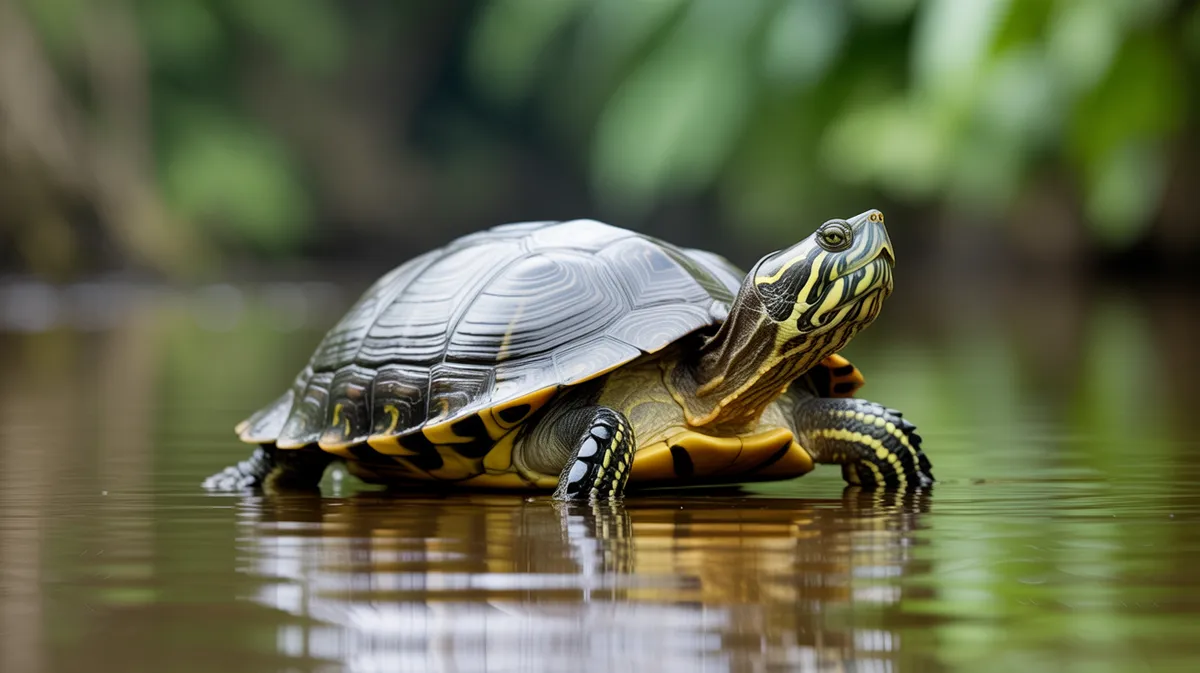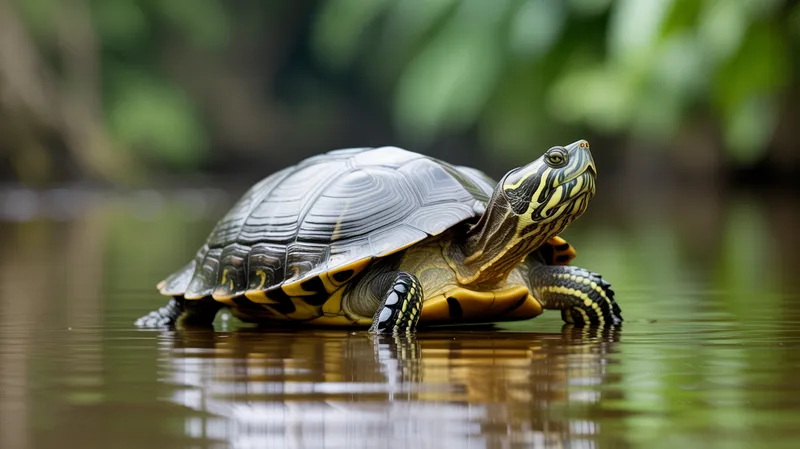
Mata Mata Turtle
Chelus fimbriata

Meet the Mata Mata Turtle
The Mata Mata Turtle is a striking freshwater turtle native to the slow-moving rivers, streams, and swamps of the Amazon and Orinoco basins in South America. This turtle is easily recognized by its large, flattened, triangular head adorned with skin flaps and a rough, knobby carapace that resembles bark or leaf litter, providing excellent camouflage. Mata Mata Turtles are highly specialized ambush predators, using their unique appearance to blend in while waiting for unsuspecting prey. They rarely swim actively and instead rely on their powerful suction feeding technique to capture fish. Despite their intimidating appearance, Mata Mata Turtles are harmless to humans.
Classification
Reptile
Habitat
Slow-moving freshwater rivers, streams, and swamps
Diet
Carnivore
Lifespan
15-30 years
Conservation
Least Concern
Weight
7-15 kg
📖Fascinating Facts
Expert Camouflage
The Mata Mata Turtle's rough, textured shell and skin flaps mimic dead leaves and debris, allowing it to blend perfectly into riverbeds and avoid detection by both predators and prey.
Suction Feeding
Rather than chasing prey, the Mata Mata Turtle opens its mouth rapidly to create a powerful vacuum, drawing fish in whole within milliseconds.
Unique Appearance
With its wide, flat head, warty skin, and extended neck, the Mata Mata Turtle looks unlike any other turtle species, making it a favorite among reptile enthusiasts.
📋Detailed Description
The Mata Mata Turtle (Chelus fimbriata) is a highly specialized freshwater turtle renowned for its extraordinary cryptic appearance, which mimics bark, leaves, and debris found in its native habitats. Adults can reach a carapace length of 35–45 cm (14–18 in) and weigh up to 15 kg (33 lbs), with males generally being smaller than females. Its broad, flattened, triangular head is fringed with fleshy skin flaps and tubercles that enhance camouflage and aid in sensory perception. The elongated neck, nearly as long as the carapace, is also adorned with skin projections and is highly flexible, allowing rapid extension during feeding. The carapace is rough, knobby, and brown to olive in color, while the plastron is narrow and cross-shaped. Mata Mata Turtles have small, lidless eyes positioned dorsally, providing a wide field of view above the water. Their mouths are wide and terminal, perfectly adapted for suction feeding. This species is almost entirely aquatic, rarely basking, and spends most of its time motionless in shallow, slow-moving waters. Its cryptic coloration and stillness make it nearly invisible to both predators and prey. The Mata Mata Turtle is solitary, with minimal social interaction outside of the breeding season. Its highly specialized morphology and feeding strategy make it one of the most unique turtles in the world.
💡 Did you know?
Despite its bizarre appearance, the Mata Mata Turtle is completely harmless and rarely leaves the water except for nesting.
🔬Research & Sources
🎭Behavior & Social Structure
Mata Mata Turtles are predominantly sedentary and rely on their camouflage to avoid detection. They are ambush predators, remaining motionless for extended periods while waiting for prey, primarily small fish, to approach. When prey is within striking distance, the turtle rapidly extends its neck and opens its mouth, creating a powerful vacuum that sucks the prey in whole—a process known as suction feeding. They do not chew, instead swallowing prey alive. Mata Mata Turtles are nocturnal or crepuscular, being most active at dusk and night. They are solitary and exhibit territorial behavior, especially during the breeding season. Social interactions are minimal, limited to brief encounters during mating. They rarely leave the water, only emerging to lay eggs or occasionally move between water bodies during seasonal changes.
👶Reproduction & Life Cycle
Mata Mata Turtles are oviparous, with breeding typically occurring during the rainy season (October to December) in the Amazon basin. Courtship involves males displaying head movements and nudging behaviors to attract females. After successful mating, females lay clutches of 12–28 spherical, brittle-shelled eggs in nests dug on sandy or muddy riverbanks. Incubation lasts approximately 200 days, with hatching synchronized to the onset of the wet season to maximize hatchling survival. There is no parental care; hatchlings are independent from birth and must fend for themselves. Sexual maturity is reached at around 5–7 years of age, depending on environmental conditions.
🛡️Adaptations & Survival
The Mata Mata Turtle exhibits several remarkable adaptations. Its cryptic morphology, including a flattened, knobby carapace and fringed skin flaps, provides exceptional camouflage among submerged leaf litter and woody debris. The skin flaps also contain mechanoreceptors that detect water movement, aiding in prey detection. Its long, tubular snout functions as a snorkel, allowing the turtle to breathe while remaining submerged and concealed. The highly specialized suction feeding mechanism enables it to capture elusive, fast-moving fish with minimal movement. Reduced swimming ability and a sedentary lifestyle minimize energy expenditure and exposure to predators. These evolutionary specializations have enabled the Mata Mata to thrive in the slow-moving, debris-rich waters of the Amazon and Orinoco basins.
📚Research Sources
🎨Cultural Significance
The Mata Mata Turtle has limited direct significance in indigenous cultures compared to other Amazonian turtles, as it is not commonly consumed due to its unpalatable flesh and cryptic habits. However, its bizarre appearance has made it a subject of fascination and curiosity among local communities and naturalists. In recent years, the Mata Mata has gained popularity in the exotic pet trade and is often featured in zoos and aquaria worldwide, contributing to public education about Amazonian biodiversity. Its unique morphology has inspired local folklore, often being described as a 'living fossil' or 'leaf turtle.'
🔬Recent Research & Discoveries
Recent molecular studies have revealed significant genetic divergence within Chelus fimbriata populations, leading to the description of a second species, Chelus orinocensis, in 2020, which is restricted to the Orinoco basin. Ongoing research focuses on the turtle's sensory adaptations, particularly the function of its skin flaps and mechanoreceptors in prey detection. Studies on its feeding mechanics have provided insights into the evolution of suction feeding in turtles. Conservation research is increasingly focused on population genetics, trade monitoring, and the impact of habitat alteration. Satellite telemetry and environmental DNA (eDNA) are being employed to better understand distribution, population structure, and habitat use.
🎥Wildlife Videos

The Matamata turtle
The mata mata, mata-mata, or matamata is a freshwater turtle found in South America. It is the only extant species in the genus ...
New Atlantis WILD

Mata Mata Turtle Facts: have YOU met the MATA MATA?
The mata mata turtle eats like a vacuum cleaner. Learn more mata mata turtle facts on today's episode of Animal Fact Files!
Animal Fact Files

Amazon Rainforest | Wildlife of the Amazon Jungle | Nature Documentary
Enjoy a full 50-minute documentary about Brazil's Amazon Rainforest "Brazil – A natural History" Part 5: Flooded Forest ...
Terra Mater

The Secret Life of Swamp Turtles Uncovered: The Mata Mata Turtle Facts!
Want to find out about the secret life of swamp turtles? The mata mata turtle facts are fascinating! The mata mata turtle is nature's ...
The Odd Earth Show

Matamata | endangered species
Interesting facts from the wild world #shorts #animal #animals #animalfacts #animalshorts #animaldocumentary #nature #wildlife.
Zoological Archive

Unmasking the Mata Mata Turtle: Nature’s Master of Disguise
Discover the fascinating world of the Mata Mata turtle (Chelus fimbriata), a true master of disguise in the animal kingdom. Native to ...
Wildwise Wonder
🌍Habitat Information
The Mata Mata Turtle typically inhabits Slow-moving freshwater rivers, streams, and swamps environments. Mata Mata Turtles have adapted to their environments with specialized features and behaviors.
Primary Habitat:
Slow-moving freshwater rivers, streams, and swamps
More detailed habitat information will be available soon.
🛡️Conservation Status
The Mata Mata Turtle is currently classified as Least Concern. Conservation efforts are crucial for preserving this species for future generations.
Common Threats:
- 🏠Habitat loss and fragmentation
- 🌡️Climate change impacts
- 🎯Hunting and poaching
- 🏭Human-wildlife conflict
⚠️Threats & Conservation Challenges
While currently listed as Least Concern by the IUCN, Mata Mata Turtles face localized threats. Habitat destruction due to deforestation, wetland drainage, and pollution from mining and agriculture impact water quality and nesting sites. Collection for the international pet trade, driven by their unique appearance, poses a significant risk, particularly in regions with weak enforcement of wildlife regulations. Climate change may alter hydrological cycles, affecting breeding success and hatchling survival. Although populations remain stable in remote areas, ongoing habitat loss and illegal trade could threaten local populations if not properly managed.
🔬Scientific Classification
Scientific Name
Chelus fimbriata
Classification Hierarchy
🔍 About Taxonomic Classification
Taxonomic classification is a hierarchical system used by scientists to classify and organize living organisms based on shared characteristics and evolutionary relationships.
The system moves from broad categories (Kingdom) to increasingly specific ones, with each animal's scientific name typically consisting of its Genus and species.
📝Community Notes
Share your observations and insights about the Mata Mata Turtle with our community of wildlife enthusiasts.
Join Our Community
Sign in to share your observations and connect with fellow wildlife enthusiasts.
Sign In to ContributeNo community notes yet
Be the first to share your observations about the Mata Mata Turtle!
Explore Mata Mata Turtle
Select a tab above to learn more about this amazing animal.
📸Photo Gallery
No photos available for this animal yet.
🌟Discover More Wildlife
Continue your journey of discovery with more fascinating animals from our database
